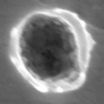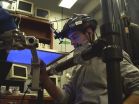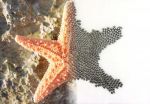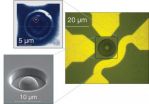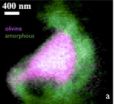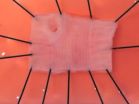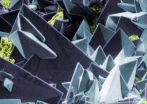(Press-News.org) Since 2006, when NASA's Stardust spacecraft delivered its aerogel and aluminum foil dust collectors to Earth, a team of scientists has combed through the collectors in search of rare, microscopic particles of interstellar dust.
The team now reports that they have found seven dust motes that probably came from outside our solar system, perhaps created in a supernova explosion millions of years ago and altered by eons of exposure to the extremes of space. They would be the first confirmed samples of contemporary interstellar dust.
"They are very precious particles," said Andrew Westphal, a physicist at the University of California, Berkeley's Space Sciences Laboratory and the lead author – with 65 main coauthors – of a report on the particles appearing in the Aug. 15 issue of the journal Science. Twelve other papers about the particles are now available online and will appear next week in the journal Meteoritics & Planetary Science.
Westphal cautioned that additional tests must still be done before the team can say definitively that these are pieces of debris from interstellar space. But if they are, the particles could help explain the origin and evolution of interstellar dust that until now could only be guessed from astronomical observations.
Specifically, these particles are much more diverse in terms of chemical composition and structure than previously thought; the small ones are much different from the big ones, and may have had different histories; and many of the big ones have a fluffy structure, like a snowflake, he said.
"The fact that the two largest fluffy particles have crystalline material – a magnesium-iron-silicate mineral called olivine – may imply that these are particles that came from the disks around other stars and were modified in the interstellar medium," he added. "We seem to be getting our first glimpse of the surprising diversity of interstellar dust particles, which is impossible to explore through astronomical observations alone."
Needles in a Haystack
Two particles, each only about two microns (thousandths of a millimeter) in diameter, were isolated from the light, fluffy aerogel detectors after their tracks were discovered by volunteers calling themselves "Dusters" who scanned more than a million images through Stardust@home, a UC Berkeley citizen-science project that proved critical to finding these needles in a haystack. A third track was made by a particle coming from the right direction – the flow of the interstellar wind – but apparently was going so fast, more than 15 kilometers per second (10 miles per second), that it vaporized. Another 29 tracks discovered by volunteers were determined to have been kicked out of the spacecraft into the collectors.
An additional 100 tracks found by Dusters have yet to be analyzed, and only 77 of the 132 aerogel panels have been scanned to date. Westphal expects to find no more than a dozen particles of interstellar dust in all – a millionth the amount of cometary material picked up by other collectors that were on board Stardust.
Four of the particles reported in Science were found in aluminum foils located between aerogel tiles on the collector tray. Although the foils were not originally planned as collection surfaces, an international team led by physicist and nanoastronomer Rhonda Stroud of the Naval Research Laboratory searched the foils for the smallest grains that might be captured, too tiny to image in the aerogel. The team identified four pits lined with partially melted material composed of elements that fit the profile of interstellar dust particles.
"They were splatted a bit, but the majority of the particles were still there at the bottom of the crater," said Stroud. "Their diversity was a surprise, but also these fluffy particles, sort of like a tossed salad, were complex, an agglomeration of other particles, rather than one dense particle suggested by the simplest models of interstellar particles."
Three of these particles, just a few tenths of a micron across, also contained sulfur compounds which some astronomers have argued do not occur in interstellar dust particles. Stroud and other members of the preliminary examination team plan to continue analysis of the remaining 95 percent of the foils, in hopes of finding enough particles to understand the variety and origins of interstellar dust.
The two aerogel-embedded particles – dubbed Orion and Hylabrook by their Duster discoverers and paper coauthors – are destined for further tests to determine their oxygen isotope abundances, which could provide even stronger evidence for an extrasolar origin. Supernovas, red giants, and other evolved stars produce interstellar dust and generate heavy elements like carbon, nitrogen and oxygen that are necessary for life.
Interstellar Snowstorm
Stardust was launched in 1999 to fly through the coma of comet Wild-2 and capture cometary dust with aerogel tiles and aluminum foils mounted on the front of a two-sided collector. Collectors mounted on the rear were designed to catch particles from the "snowstorm of interstellar dust streaming through the galaxy," said UC Berkeley research physicist Anna Butterworth.
"This dust is relatively new, since the lifetime of interstellar dust is only 50 to 100 million years, so we are sampling our contemporary galaxy," said Butterworth.
The separate comet and interstellar dust collectors, each a tennis-racket sized mosaic of 132 aerogel tiles, were dropped by parachute as Stardust flew by Earth in 2006, and a consortium of scientists led by Westphal began to analyze the interstellar collectors. Scientists at the Johnson Space Center in Houston have scanned half the panels at various depths through the transparent aerogel and turned these scans into movies. Westphal and his team tailored the movies for their virtual microscope, allowing Dusters,714 are coauthors of the Science paper – to go online and search for tracks as if focusing a microscope at different depths.
"We expected to find grains less than a micron across that would leave a track a couple of microns wide. That is about one-fiftieth the width of a human hair. We might not see the particles in an optical microscope, so the Dusters are looking for the impact tracks they made," Butterworth said.
Once several Dusters tagged a likely track, Westphal's team vetted them. In the million frames scanned, each a half-millimeter square, Dusters found 69 tracks, while Westphal found two.
Thirty-one of these were extracted along with surrounding aerogel by scientists at Johnson Space Center and shipped to UC Berkeley to be analyzed by a scanning transmission x-ray microscope, or STXM, attached to a synchrotron beam line at the Advanced Light Source at Lawrence Berkeley National Laboratory. STXM used soft x-rays to probe the chemical composition, and ruled out 29 grains because they contained aluminum metal, which does not occur in space, or other substances probably knocked out of the spacecraft and embedded in the aerogel.
Stardust@home will continue to analyze the remaining detector aerogel tiles once Phase 7 starts on Aug. 15. Foil analysis will also be incorporated into the project soon.
"As one of the first citizen-science projects, Stardust@home has been an amazing success," said Butterworth, who is first author of one of the 12 MAPS papers about the project. "If we had had one person searching the aerogel 40 hours per week, they would have taken three years to cover once the same area searched multiple times by the Dusters."
INFORMATION:
The Stardust analysis was funded primarily by NASA, with additional resources from the Department of Energy.
Seven tiny grains captured by Stardust likely visitors from interstellar space
Probable interstellar dust particles surprisingly fluffy
2014-08-14
ELSE PRESS RELEASES FROM THIS DATE:
Memories of errors foster faster learning
2014-08-14
Using a deceptively simple set of experiments, researchers at Johns Hopkins have learned why people learn an identical or similar task faster the second, third and subsequent time around. The reason: They are aided not only by memories of how to perform the task, but also by memories of the errors made the first time.
"In learning a new motor task, there appear to be two processes happening at once," says Reza Shadmehr, Ph.D., a professor in the Department of Biomedical Engineering at the Johns Hopkins University School of Medicine. "One is the learning of the motor ...
Harnessing the power of bacteria's sophisticated immune system
2014-08-14
Bacteria's ability to destroy viruses has long puzzled scientists, but researchers at the Johns Hopkins Bloomberg School of Public Health say they now have a clear picture of the bacterial immune system and say its unique shape is likely why bacteria can so quickly recognize and destroy their assailants.
The researchers drew what they say is the first-ever picture of the molecular machinery, known as Cascade, which stands guard inside bacterial cells. To their surprise, they found it contains a two-strand, unencumbered structure that resembles a ladder, freeing it to ...
Message to parents: Babies don't 'start from scratch'
2014-08-14
There's now overwhelming evidence that a child's future health is influenced by more than just their parents' genetic material, and that children born of unhealthy parents will already be pre-programmed for greater risk of poor health, according to University of Adelaide researchers.
In a feature paper called "Parenting from before conception" published in today's issue of the top international journal Science, researchers at the University's Robinson Research Institute say environmental factors prior to conception have more influence on the child's future than previously ...
A self-organizing thousand-robot swarm
2014-08-14
Cambridge, Mass. – August 14, 2014 – The first thousand-robot flash mob has assembled at Harvard University.
"Form a sea star shape," directs a computer scientist, sending the command to 1,024 little bots simultaneously via an infrared light. The robots begin to blink at one another and then gradually arrange themselves into a five-pointed star. "Now form the letter K."
The 'K' stands for Kilobots, the name given to these extremely simple robots, each just a few centimeters across, standing on three pin-like legs. Instead of one highly-complex robot, a "kilo" of robots ...
Molecular engineers record an electron's quantum behavior
2014-08-14
A team of researchers led by the University of Chicago has developed a technique to record the quantum mechanical behavior of an individual electron contained within a nanoscale defect in diamond. Their technique uses ultrafast pulses of laser light both to control the defect's entire quantum state and observe how that single electron state changes over time. The work appears in this week's online Science Express and will be published in print later this month in Science.
This research contributes to the emerging science of quantum information processing, which demands ...
Mysteries of space dust revealed
2014-08-14
The first analysis of space dust collected by a special collector onboard NASA's Stardust mission and sent back to Earth for study in 2006 suggests the tiny specks, which likely originated from beyond our solar system, are more complex in composition and structure than previously imagined.
The analysis, completed at a number of facilities including the U.S. Department of Energy's Lawrence Berkeley National Lab (Berkeley Lab) opens a door to studying the origins of the solar system and possibly the origin of life itself.
"Fundamentally, the solar system and everything ...
New Milky Way maps help solve stubborn interstellar material mystery
2014-08-14
An international team of sky scholars, including a key researcher from Johns Hopkins, has produced new maps of the material located between the stars in the Milky Way. The results should move astronomers closer to cracking a stardust puzzle that has vexed them for nearly a century.
The maps and an accompanying journal article appear in the Aug. 15 issue of the journal Science. The researchers say their work demonstrates a new way of uncovering the location and eventually the composition of the interstellar medium—the material found in the vast expanse between star systems ...
CF mucus defect present at birth
2014-08-14
VIDEO:
This is a 3-D reconstruction from time-lapse CT-scans of a CF pig lung. Images show the trachea and bronchi. Colored round dots represent positions of particles that were...
Click here for more information.
Mucus is key to keeping our lungs clean and clear of bacteria, viruses, and other foreign particles that can cause infection and inflammation. When we inhale microbes and dust, they are trapped in the mucus and then swept up and out of the lungs via a process called ...
Potential drug therapy for kidney stones identified in mouse study
2014-08-14
Anyone who has suffered from kidney stones is keenly aware of the lack of drugs to treat the condition, which often causes excruciating pain.
A new mouse study, however, suggests that a class of drugs approved to treat leukemia and epilepsy also may be effective against kidney stones, researchers at Washington University School of Medicine in St. Louis report.
The drugs are histone deacetylase inhibitors, or HDAC inhibitors for short. The researchers found that two of them — Vorinostat and trichostatin A — lower levels of calcium and magnesium in the urine. Both calcium ...
Broader organ sharing won't harm liver transplant recipients
2014-08-14
New research shows that broader sharing of deceased donor livers will not significantly increase cold ischemia time (CIT)—the time the liver is in a cooled state outside the donor suggesting that this is not a barrier to broader sharing of organs. However, findings published in Liver Transplantation, a journal of the American Association for the Study of Liver Diseases and the International Liver Transplantation Society, do indicate that broader sharing of organs will significantly increase the percentage of donor organs that are transported by flying rather than driving. ...
LAST 30 PRESS RELEASES:
Air pollution exposure and birth weight
Obstructive sleep apnea risk and mental health conditions among older adults
How talking slows eye movements behind the wheel
The Ceramic Society of Japan’s Oxoate Ceramics Research Association launches new international book project
Heart-brain connection: international study reveals the role of the vagus nerve in keeping the heart young
Researchers identify Rb1 as a predictive biomarker for a new therapeutic strategy in some breast cancers
Survey reveals ethical gaps slowing AI adoption in pediatric surgery
Stimulant ADHD medications work differently than thought
AI overestimates how smart people are, according to HSE economists
HSE researchers create genome-wide map of quadruplexes
Scientists boost cell "powerhouses" to burn more calories
Automatic label checking: The missing step in making reliable medical AI
Low daily alcohol intake linked to 50% heightened mouth cancer risk in India
American Meteorological Society announces Rick Spinrad as 2026 President-Elect
Biomass-based carbon capture spotlighted in newly released global climate webinar recording
Illuminating invisible nano pollutants: advanced bioimaging tracks the full journey of emerging nanoscale contaminants in living systems
How does age affect recovery from spinal cord injury?
Novel AI tool offers prognosis for patients with head and neck cancer
Fathers’ microplastic exposure tied to their children’s metabolic problems
Research validates laboratory model for studying high-grade serous ovarian cancer
SIR 2026 delivers transformative breakthroughs in minimally invasive medicine to improve patient care
Stem Cell Reports most downloaded papers of 2025 highlight the breadth and impact of stem cell research
Oxford-led study estimates NHS spends around 3% of its primary and secondary care budget on the health impacts of heat and cold in England
A researcher’s long quest leads to a smart composite breakthrough
Urban wild bees act as “microbial sensors” of city health.
New study finds where you live affects recovery after a hip fracture
Forecasting the impact of fully automated vehicle adoption on US road traffic injuries
Alcohol-related hospitalizations from 2016 to 2022
Semaglutide and hospitalizations in patients with obesity and established cardiovascular disease
Researchers ‘listen in’ to embryo-mother interactions during implantation using a culture system replicating the womb lining
[Press-News.org] Seven tiny grains captured by Stardust likely visitors from interstellar spaceProbable interstellar dust particles surprisingly fluffy
